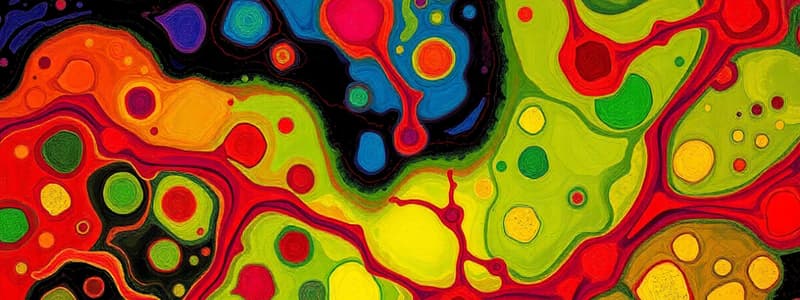Podcast
Questions and Answers
What process describes the restoration of tissue architecture and function after injury?
What process describes the restoration of tissue architecture and function after injury?
- Fibrosis
- Repair (correct)
- Healing
- Regeneration
Which of the following cell types plays a significant role in creating new blood vessels during tissue repair?
Which of the following cell types plays a significant role in creating new blood vessels during tissue repair?
- Macrophages
- Fibroblasts
- Stem cells
- Vascular endothelial cells (correct)
What term is used to describe the extensive deposition of collagen due to chronic inflammation?
What term is used to describe the extensive deposition of collagen due to chronic inflammation?
- Scarring
- Regeneration
- Organization
- Fibrosis (correct)
Which sequence correctly represents the steps involved in healing and repair?
Which sequence correctly represents the steps involved in healing and repair?
What is the nature of granulation tissue formed during the healing process?
What is the nature of granulation tissue formed during the healing process?
In the context of tissue repair, what does the term 'remnants of the injured tissue' refer to?
In the context of tissue repair, what does the term 'remnants of the injured tissue' refer to?
What term describes the process of repairing tissue when supporting structures are severely damaged?
What term describes the process of repairing tissue when supporting structures are severely damaged?
What drives the proliferation of various cell types involved in tissue repair?
What drives the proliferation of various cell types involved in tissue repair?
What does angiogenesis primarily involve in the context of healing?
What does angiogenesis primarily involve in the context of healing?
Which growth factor is primarily associated with stimulating angiogenesis?
Which growth factor is primarily associated with stimulating angiogenesis?
What signifies the hallmark of granulation tissue?
What signifies the hallmark of granulation tissue?
What role do metalloproteinases play in the remodeling phase of tissue healing?
What role do metalloproteinases play in the remodeling phase of tissue healing?
How long after an injury does ECM deposition begin in the wound healing process?
How long after an injury does ECM deposition begin in the wound healing process?
What characterizes healing by primary intention?
What characterizes healing by primary intention?
Which of the following components is NOT typically associated with extracellular matrix (ECM) deposition?
Which of the following components is NOT typically associated with extracellular matrix (ECM) deposition?
What is a key characteristic of fibroblastic proliferation during wound healing?
What is a key characteristic of fibroblastic proliferation during wound healing?
What is primarily responsible for wound contraction in large surface wounds during secondary healing?
What is primarily responsible for wound contraction in large surface wounds during secondary healing?
Which type of scar tissue grows beyond the boundaries of the original wound and does not regress?
Which type of scar tissue grows beyond the boundaries of the original wound and does not regress?
During what time frame does the strength of a wound reach approximately 10% of unwounded skin strength?
During what time frame does the strength of a wound reach approximately 10% of unwounded skin strength?
Which factor is NOT typically considered a local factor influencing wound healing?
Which factor is NOT typically considered a local factor influencing wound healing?
What results in excessive collagen synthesis leading to increased wound strength over time?
What results in excessive collagen synthesis leading to increased wound strength over time?
What is a potential complication that can result from deficient scar formation and inadequate granulation tissue formation?
What is a potential complication that can result from deficient scar formation and inadequate granulation tissue formation?
Which type of scar results from an accumulation of collagen and appears raised?
Which type of scar results from an accumulation of collagen and appears raised?
What process is primarily intensified in secondary healing due to the larger fibrin clot and necrotic debris?
What process is primarily intensified in secondary healing due to the larger fibrin clot and necrotic debris?
What is the main characteristic of healing by first intention?
What is the main characteristic of healing by first intention?
What occurs at the wound margins within 24 hours after an incision?
What occurs at the wound margins within 24 hours after an incision?
What happens to the neutrophils by the third day post-incision?
What happens to the neutrophils by the third day post-incision?
What is the primary role of granulation tissue during the healing process?
What is the primary role of granulation tissue during the healing process?
What key change occurs in the wound area by the end of the first month following healing?
What key change occurs in the wound area by the end of the first month following healing?
Which of the following best describes healing by second intention?
Which of the following best describes healing by second intention?
What aspect of a wound's healing process continues during the second week?
What aspect of a wound's healing process continues during the second week?
What happens to the tensile strength of a wound over time after healing?
What happens to the tensile strength of a wound over time after healing?
Study Notes
Tissue Repair
- Tissue repair is the process of replacing dead cells with healthy tissue after injury.
- Repair occurs through two processes: regeneration and healing by connective tissue formation.
- Regeneration involves replacement of damaged components with identical cells.
- Healing by connective tissue occurs when complete restitution is impossible and involves scar formation.
- Fibrosis describes extensive collagen deposition during chronic inflammation or ischemic necrosis (infarction).
- Organization refers to fibrosis developing in a tissue space occupied by inflammatory exudate.
Cell Types Involved in Repair
- Several cell types proliferate during tissue repair.
- These include remnants of the injured tissue, vascular endothelial cells, and fibroblasts.
- Proliferation of these cells is driven by proteins called growth factors.
Steps of Healing and Repair
- Scavenging: Removal of dead tissue by macrophages.
- Regeneration: Replacement of lost cells by multiplication of their neighbors.
- Granulation tissue formation: Marks healing with two main components: angiogenesis and fibroblastic proliferation.
- Synthesis and deposition of ECM: Fibroblasts deposit increasing amounts of ECM, promoting strength in healing wounds.
- Tissue remodelling: Maturation of scar tissue through balance between deposition and degradation of ECM.
Regeneration
- Regeneration occurs in cells with the ability to proliferate (labile and stable cells).
- Cells are classified into three groups based on their proliferative capacity:
- Labile cells: Continuous cell division (e.g., epithelial cells).
- Stable cells: Can divide upon stimulation (e.g., liver cells).
- Permanent cells: Limited or no proliferative capacity (e.g., neurons).
Granulation Tissue
- Granulation tissue is characterized by:
- Pink, soft, and granular appearance.
- Angiogenesis (formation of new blood vessels).
- Fibroblastic proliferation.
- Leaky nature (edema).
Angiogenesis
- Formation of new small blood vessels.
- Two main mechanisms:
- Capillary sprouts from adjacent vessels.
- Mobilization of endothelial precursor cells from the bone marrow.
- Stimulated by growth factors like VEGF and angiopoietin (secreted by various cells).
- Essential for healing, tumor growth, and revascularization of ischemic tissues.
Fibroblastic Proliferation
- Fibroblasts proliferate and migrate into the granulation tissue framework.
- This process is driven by growth factors and cytokines (e.g., PDGF, FGF, TNF, IL1).
ECM Deposition
- As the process progresses, fibroblasts deposit ECM, primarily fibrillar collagen.
- Promotes strength in healing wounds.
- Begins 3-5 days after injury and continues for weeks.
- Enhanced by growth factors (PDGF, FGF) and cytokines.
Remodelling
- Maturation and organization of fibrous tissue (scar).
- Achieved through balance between deposition and degradation of ECM.
- Degradation is facilitated by metalloproteinases, enzymes that depend on zinc ions and are stimulated by growth factors.
- Vascular regression occurs as the scar matures, resulting in a pale, avascular appearance.
Cutaneous Wound Healing
- Skin wounds heal by primary intention or secondary intention.
- The distinction depends on the nature of the wound, not the healing process itself.
Healing by First Intention (Wounds with Opposed Edges)
- Occurs in clean, uninfected surgical incisions sutured together.
- Involves a minimal amount of cell death.
- Healing follows a series of sequential steps:
- Within 24 hours: Neutrophils migrate toward the fibrin clot.
- 24 to 48 hours: Epithelial cells move from the wound edges and fuse, forming a continuous epithelial layer.
- Day 3: Neutrophils are replaced by macrophages, and granulation tissue invades the incision.
- Day 5: The incisional space is filled with granulation tissue, neovascularization is maximal, and collagen begins to bridge the incision.
- Second week: Continued collagen accumulation and fibroblast proliferation.
- End of the first month: The scar is made of cellular connective tissue covered by intact epidermis.
Healing by Second Intention (Wounds with Separated Edges)
- Occurs with more extensive tissue loss.
- Regenerating cells cannot fully restore the original architecture.
- Abundant granulation tissue fills the defect.
- Features include:
- Larger fibrin clot with more necrotic debris and exudate.
- Intense inflammatory reaction.
- More granulation tissue formation.
- Wound contraction by myofibroblasts.
- Significant scar formation and thinning of the epidermis.
Wound Strength
- At the end of the first week, wound strength reaches 10% of unwounded skin.
- Gradually increases over the next few weeks, reaching 70-80% of normal strength.
- Result of excessive collagen synthesis.
Factors Influencing Healing
- Factors influencing healing include:
- Systemic factors: Age, nutrition, diabetes, steroid use, smoking.
- Local factors: Infection, foreign bodies, blood supply, wound tension.
Complications of Cutaneous Wound Healing
- Excessive scar tissue formation:
- Hypertrophic scar: Raised scar due to excessive collagen accumulation.
- Keloid: Scar tissue grows beyond the original wound boundaries and does not regress.
- Deficient scar formation: Wound dehiscence (more common in abdominal surgery).
- Formation of contracture: Exaggerated wound contraction leading to deformity.
Studying That Suits You
Use AI to generate personalized quizzes and flashcards to suit your learning preferences.
Related Documents
Description
This quiz explores the complex processes of tissue repair, including regeneration and healing. You'll learn about the different cell types involved in repairing tissues and the steps in the healing process. Test your knowledge on how cells proliferate and the roles they play in recovery after injury.




